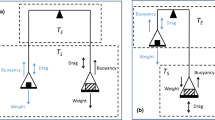Abstract
Lattice-gas models for CO oxidation can exhibit a discontinuous nonequilibrium transition between reactive and inactive states, which disappears above a critical CO-desorption rate. Using finite-size-scaling analysis, we demonstrate a crossover from Ising to mean-field behavior at the critical point, with increasing surface mobility of adsorbed CO or with decreasing system size. This behavior is elucidated by analogy with that of equilibrium Ising-type systems with long-range interactions.
Similar content being viewed by others
REFERENCES
H. Haken, Rev. Mod. Phys. 47:67 (1975).
A. S. Mikhailov, Foundations of Synergetics I: Distributed Active Systems (Springer-Verlag, Berlin, 1990).
A. Nitzan and P. Ortoleva, Phys. Rev. A 21:1735 (1980).
J. Marro and R. Dickman, Nonequilibrium Phase Transitions in Lattice Models (Cambridge University Press, Cambridge, 1999).
R. M. Ziff, E. Gulari, and Y. Barshad, Phys. Rev. Lett. 56:2553 (1986).
J. W. Evans, D.-J. Liu, and M. Tammaro, Chaos 12:131 (2002).
D.-J. Liu and J. W. Evans, Phys. Rev. Lett. 84:955 (2000).
B. Schmittmann and R. K. P. Zia, Phys. Rep. 301:45 (1998).
J. M. Gonzalez-Miranda, P. L. Garido, J. Marro, and J. L. Lebowitz, Phys. Rev. Lett. 59:1934 (1987).
A. de Masi, P. A. Ferrari, and J. L. Lebowitz, Phys. Rev. Lett. 55:1947 (1985).
D.-J. Liu and J. W. Evans, J. Chem. Phys. 117:7319 (2002).
J. W. Evans and M. Tammaro, in Computer Simulation Studies in Condensed-Matter Physics, D. P. Landau and H.-B. Schuttler, eds. (Springer, Berlin, 1999), Vol. XI, p. 103.
C. Borgs and W. Janke, Phys. Rev. Lett. 68:1738 (1992).
K. K. Mon and K. Binder, Phys. Rev. E 48:2498 (1993).
E. Luijten, H. W. J. Blöte, and K. Binder, Phys. Rev. E 54:4626 (1996).
V. Privman and M. E. Fisher, J. Stat. Phys. 33:385 (1983).
T. Tomé and R. Dickman, Phys. Rev. E 47:948 (1993).
N. Pavlenko, R. Imbihl, J. W. Evans, and D.-J. Liu, Phys. Rev. E 68:016212 (2003).
B. J. Brosilow and R. M. Ziff, Phys. Rev. A 46:4534 (1992).
J. W. Evans and M. Sabella, Trends Stat. Phys. 1:107 (1994).
M. Tammaro, M. Sabella, and J. W. Evans, J. Chem. Phys. 103:10277 (1995).
P. C. Hohenberg and B. I. Halperin, Rev. Mod. Phys. 49:435 (1977).
For small values of “bare” hop rate h, D scales differently h, as spatial coupling from two-site adsorption and reaction processes competes with that from diffusion. One expects that D ~ c + h, where c = O(1). See E. Clément, P. Leroux-Hugon, and L. M. Sander, Phys. Rev. Lett. 67:1661 (1991); J. W. Evans and T. R. Ray, Phys. Rev. E 50:4302 (1994).
R. Imbihl and G. Ertl, Chem. Rev. 95:697 (1995).
E. Luijten, H. W. J. Blöte, and K. Binder, Phys. Rev. E 56:6540 (1997).
U. C. Täuber, Acta Physica Slovaca 52:505 (2002), cond-mat/0205327.
H. Hinrichsen, Adv. Phys. 49:815 (2000).
Y. Suchorski, J. Beben, E. W. James, J. W. Evans, and R. Imbihl, Phys. Rev. Lett. 82:1907 (1999).
Y. Suchorski, J. Beben, R. Imbihl, E. W. James, D.-J. Liu, and J. W. Evans, Phys. Rev. B 63:165417 (2001).
In real reaction systems, we expect that the chemical diffusion rates (rather than the microscopic hop rates) controls crossover. Increased coverage does not necessarily reduce chemical diffusivity in single species adlayers. However, it is generally expected to reduce chemical diffusivity in mixed adlayers due to effects of percolation and interactions, see, e.g., D.-J. Liu and J. W. Evans, J. Chem. Phys. 113:10252 (2000).
P. Hanggi, H. Grabert, P. Talkner, and H. Thomas, Phys. Rev. A 29:371 (1984).
H. Malchow and L. Schimansky-Geier, in Noise and Diffusion in Bistable Nonequilibrium Systems, Teubner Texte zur Physik, W. Ebeling, W. Meiling, A. Uhlmann, and B. Wilhelmi, eds. (Teubner Verlag, Leipzig, 1986).
C. W. Gardiner, in Handbook of Stochastic Methods for Physics, Chemistry and the Natural Sciences, Springer Series in Synergetics, H. Haken, ed. (Springer-Verlag, Berlin, 1983).
J. Zinn-Justin, Quantum Field Theory and Critical Phenomena, 4th ed. (Clarendon Press, Oxford, 2002), p. 859.
M. N. Barber, in Phase Transitions and Critical Phenomena, C. Domb and J. L. Lebowitz, eds. (Academic Press, New York, 1983), Vol. 8, pp. 146–268.
Author information
Authors and Affiliations
Rights and permissions
About this article
Cite this article
Liu, DJ., Pavlenko, N. & Evans, J.W. Crossover Between Mean-Field and Ising Critical Behavior in a Lattice-Gas Reaction-Diffusion Model. Journal of Statistical Physics 114, 101–114 (2004). https://doi.org/10.1023/B:JOSS.0000003105.50683.c6
Issue Date:
DOI: https://doi.org/10.1023/B:JOSS.0000003105.50683.c6




